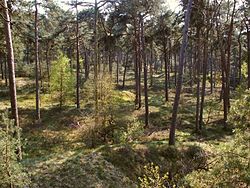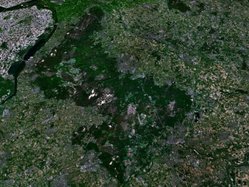- Veluwe
-
The Veluwe is a forest-rich ridge of hills (1100 km²) in the province of Gelderland in the Netherlands. The Veluwe features many different landscapes including woodland, heath, some small lakes and Europe's largest sand drifts.
The Veluwe is the largest push moraine complex in the Netherlands, stretching 60 km from north to south, and reaching heights of up to 110 meters. The Veluwe was formed by the Saalian glacial during the Pleistocene epoch, some 200,000 years ago. Glaciers some 200 meters thick[citation needed] pushed the sand deposits in the Rhine and Maas Delta sideways, creating the hills which now form most of the Veluwe. Because the hills are made of sand, rain water disappears rapidly, and then it flows at a depth of tens of meters to the edges where it reaches the surface again.
Originally the Veluwe was surrounded by a string of swamps, heavily populated with game such as deer and wild boars because these areas offered rich vegetation to feed on. Since the 1990s many plans are underway, or have already been implemented, to restore these wetlands by blocking the drainage systems built by farmers during the last 150 years. This results in very dry heathland changing into wetland within a span of just a few hundred meters. The Wisselse Veen near the village of Epe, on the North East Veluwe, offers a good example of this.[citation needed]
Contents
Flora and fauna
There are both coniferous and deciduous forests on the Veluwe, and some 500 different plant species can be found. The region is also home to many different species of animals, such as wild boars, several species of deer, several species of snakes, including the common viper, Pine Martens, foxes, and badgers. Furthermore, the bird raven was successfully reintroduced, and the exotic Reeves's muntjac and mouflon can be seen sometimes. In all, the Veluwe is among the best places in the Netherlands to see wildlife.[citation needed]
Developments
Parts of the Veluwe that have been separated from each other by roads, towns and farmland are being reconnected by returning farmland to nature and creating wildlife crossings over highways. In 2007, three of these overpasses had been built, each one about 50 meters wide and covered with sand and vegetation to encourage animals to use it. Six more will be built in the next five years.[1] Wildlife corridors connecting the Veluwe to other wildlife areas such as the Oostvaardersplassen in the Netherlands and the Klever Reichswald in Germany are being developed. It is hoped that by doing so the genetic diversity of the wildlife population will increase.
Tourism and recreation
The Veluwe is a popular tourist destination, especially for Dutch people wanting to go on a short vacation in their own country. Campsites and bungalow parks are the preferred place to stay for most visitors. There are more than 500 of these sites, more than in all of Switzerland. Most of these are located on the outskirts of the natural area. One of the bungalow parks located in a more sensitive natural area was removed around 2004, and there are other candidates. In order to turn the entire Veluwe into one large National Park, and meet the IUCN standards for a National Park (a IUCN-category two area), such moves are necessary. Removing remaining fences, as around De Hoge Veluwe and some other areas, is also essential. Around 2006, an old industrial zone near the village of Renkum was cleared away because it blocked a valley that was important for the migration of wildlife. A military complex near Nunspeet was removed instead of being redeveloped as a business area.
Besides the natural beauty of the area, other tourist attractions include four zoos, over 50 museums including the famous Kröller-Müller art museum, and the royal palace Het Loo at Apeldoorn. The National Sports Centre Papendal, a large sports complex and Olympic Games training facility is located in the south of the Veluwe near Arnhem.
Etymology
Veluwe derives from Germanic *falwa (pale) in the sense of "infertile" or "unproductive".[2] The name corresponds to "fallow lands" in English and probably was used in opposition to the fertile "good lands" of the Betuwe to the south.
Towns and Cities
There are 21 municipalities in the Veluwe region: Apeldoorn, Arnhem, Barneveld, Brummen, Ede, Elburg, Epe, Ermelo, Harderwijk, Hattem, Heerde, Nijkerk, Nunspeet, Oldebroek, Putten, Renkum, Rheden, Rozendaal, Scherpenzeel, Voorst and Wageningen.
See also
External links
References
- ^ (Dutch) Province of Gelderland, factsheet wildlife crossings
- ^ [1] Nederlands Etymologisch Woordenboek - J. de Vries
Categories:
Wikimedia Foundation. 2010.


